
Orchids are plants that belong to the family Orchidaceae, a diverse and widespread group of flowering plants with blooms that are often colourful and fragrant. Orchids are cosmopolitan plants that are found in almost every habitat on Earth except glaciers. The world's richest diversity of orchid genera and species is found in the tropics.

The Pleurothallidinae are a neotropical subtribe of plants of the orchid family (Orchidaceae) including 29 genera in more than 4000 species.

In the botanical classification of plants, Aeridinae Pfitzer is a subtribe of the tribe Vandeae whose representatives all have a monopodial growth habit and do not possess pseudobulbs.

Cypripedioideae is a subfamily of orchids commonly known as lady's slipper orchids, lady slipper orchids or slipper orchids. Cypripedioideae includes the genera Cypripedium, Mexipedium, Paphiopedilum, Phragmipedium and Selenipedium. They are characterised by the slipper-shaped pouches of the flowers – the pouch traps insects so they are forced to climb up past the staminode, behind which they collect or deposit pollinia, thus fertilizing the flower. There are approximately 165 species in the subfamily.

The Orchidoideae, or the orchidoid orchids, are a subfamily of the orchid family (Orchidaceae) that contains around 3630 species. Species typically have a single (monandrous), fertile anther which is erect and basitonic.

The Oncidiinae is a subtribe within the Orchidaceae that consists of a number of genera that are closely related.
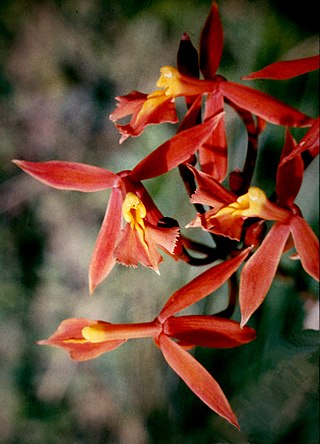
Epidendroideae is a subfamily of plants in the orchid family, Orchidaceae. Epidendroideae is larger than all the other orchid subfamilies together, comprising more than 15,000 species in 576 genera. Most epidendroid orchids are tropical epiphytes, typically with pseudobulbs. There are, however, some terrestrials such as Epipactis and even a few myco-heterotrophs, which are parasitic upon mycorrhizal fungi.

Caladenia, commonly known as spider orchids, is a genus of 350 species of plants in the orchid family, Orchidaceae. Spider orchids are terrestrial herbs with a single hairy leaf and a hairy stem. The labellum is fringed or toothed in most species and there are small projections called calli on the labellum. The flowers have adaptations to attract particular species of insects for pollination. The genus is divided into three groups on the basis of flower shape, broadly, spider orchids, zebra orchids and cowslip orchids, although other common names are often used. Although they occur in other countries, most are Australian and 136 species occur in Western Australia, making it the most species-rich orchid genus in that state.
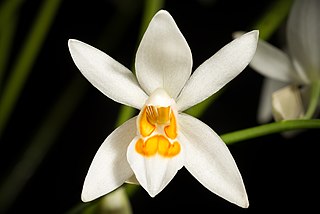
Arethuseae is a mid-sized tribe of orchids in the subfamily Epidendroideae. This tribe was initially categorized by John Lindley in 1840. Its largest subtribes are Arethusinae and Coelogyninae.
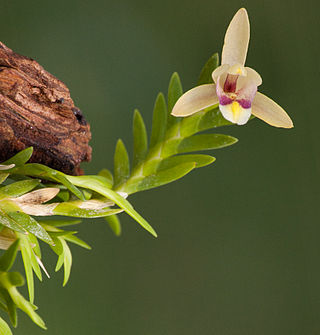
The Vandeae is a large monophyletic tribe within the family of orchids.
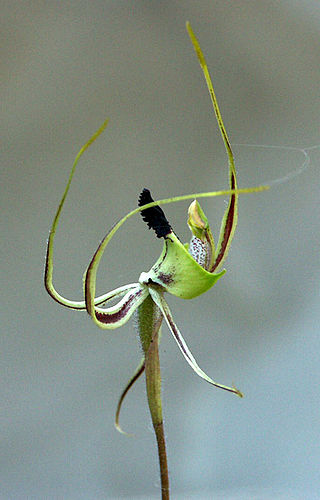
Caladenia integra, commonly known as the smooth-lipped spider orchid is a species of plant in the orchid family, Orchidaceae and is endemic to the south-west of Western Australia. It can be distinguished by its distinctive smooth-edged labellum and its upswept lateral sepals.
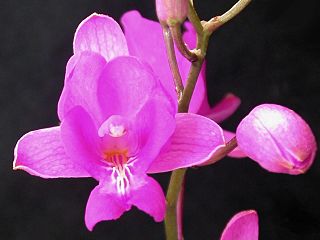
The tribe Epidendreae of the Orchidaceae comprises six subtribes:
Elythranthera, commonly known as enamel orchids, is a genus of flowering plants in the orchid family, Orchidaceae. It contains two species and a named hybrid, all endemic to the south-west of Western Australia. The genus was first formally described in 1963 by the Australian botanist Alex George who published his description in Western Australian Naturalist.

Dendrobieae is a tribe in the subfamily Epidendroideae, in the family Orchidaceae. The Dendrobieae are mostly tropical, epiphytic orchids which contain pseudobulbs.

Cranichideae is an orchid tribe in the subfamily Orchidoideae.

Orchideae is a tribe of orchids in the subfamily Orchidoideae. Historically, it was divided into 2 subtribes, Orchidinae and Habenariinae. The subtribe Orchidinae alone contains about 1,800 species. However, although some phylogenetic studies have established the monophyly of the subtribes, the generic boundaries are unclear, with many genera as traditionally circumscribed being paraphyletic or even polyphyletic. Species of genera such as Habenaria and Platanthera have been placed into both subtribes. A 2017 molecular phylogenetic study found that both subtribes did form clades, but did not formally recognize Habenariinae, because of missing genera and uncertainty over generic boundaries. The Asian species of Orchideae, in particular, have been subject to repeated changes of generic placement from 2012 onwards.

Spiranthinae is an orchid subtribe in the tribe Cranichideae.
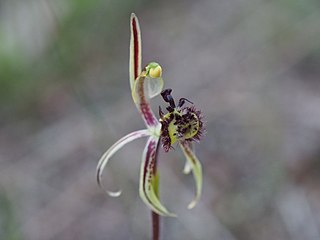
Caladenia barbarossa, commonly known as the common dragon orchid is a species of orchid endemic to the south-west of Western Australia. It can be distinguished by its distinctive labellum which is attractive to species of male thynnid wasps.
Caladenia subglabriphylla is a plant in the orchid family Orchidaceae and is endemic to southern Australia. It was first formally described in 2014 by Robert Bates who gave it the name Arachnorchis subglabriphylla and published the description in Australian Orchid Review. In 2015 Mark Clements changed the name to Caladenia subglabriphylla and published the change in American Journal of Botany. The specific epithet (subglabriphylla) is derived from the Latin prefix sub- meaning "somewhat" or "less than", the word glabrum meaning "hairless", "bald" or "smooth" and the Ancient Greek word phyllon meaning "leaf", hence "almost hairless leaf".
Mark Alwin Clements (b. 1949) is an Australian botanist and orchidologist. He obtained his doctorate at the Australian National University defending his thesis entitled Reproductive Biology in relation to phylogeny of the Orchidaceae, especially the tribe Diurideae.

















